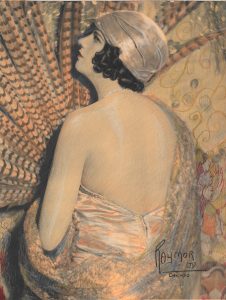Magazine

“Our Handsomest Girls are Men”
A class at the University of Michigan uses Bentley materials to teach students about U-M’s history of female impersonators.
by Cinda Nofziger
Lionel Ames would have been used to the spotlight.
He was a University of Michigan School of Music student from 1921–24, a member of Beta Phi Delta fraternity, a member of the Mimes of the Michigan Union, and a player in multiple Michigan Union operas.
Ames played the lead female parts in the 1922 and 1923 Mimes productions In and Out and Cotton Stockings (Never Made a Man Look Twice). In a review of Cotton Stockings in 1923, a Toledo reviewer described Ames as “a corking impersonator of the feminine. He has a Kitty Gordon back, a figure that can wear stunning plumage to advantage, an assuring stage presence and can dance with ease and grace.”
In his American Culture class, “Transgender American Histories,” University of Michigan lecturer Scott Larson uses the story and images of Ames and the Michigan Mimes, found in the Michigan Union records at the Bentley, to understand broader themes in U.S. history.

Lionel Ames in a performance of Cotton Stockings circa 1920.
For example, by studying Ames, the content of the Michigan operas, and how the local and national press discussed them, current students can see that anxiety about gender crossing can be connected to anxieties about women’s dress, women’s suffrage, and feminism. Reaction to female impersonators demonstrates concerns about the role of colleges as places where students might engage in low culture (read: popular culture), drinking, and concerns about the “potential for campuses to be incubators for homosexuality,” Larson says.
In spite of Ames being a standout, female impersonation was not unique to Michigan. A 1924 article from the Washington Post cites Princeton, the University of Pennsylvania, as well as the University of Michigan as schools famously using men to play women’s parts.
Larson says that this was part of a “larger explosion of vaudeville, flappers, speakeasies, and dance halls.” Ames and the Michigan Union opera fit into a “national interest in gender crossing as comic theater.” It was not transgressive, but part of the dominant culture.
The Mimes even took their shows on the road. Both the Michigan Union opera and the Mimes toured regionally, with Cotton Stockings also playing at the Metropolitan Opera House in New York City, Washington, D.C., and Philadelphia.
Larson hopes the material related to Ames and the Michigan Union opera will help students realize that gender crossing didn’t just happen in places like New York or San Francisco. The University of Michigan and its students also have a place in that history.
